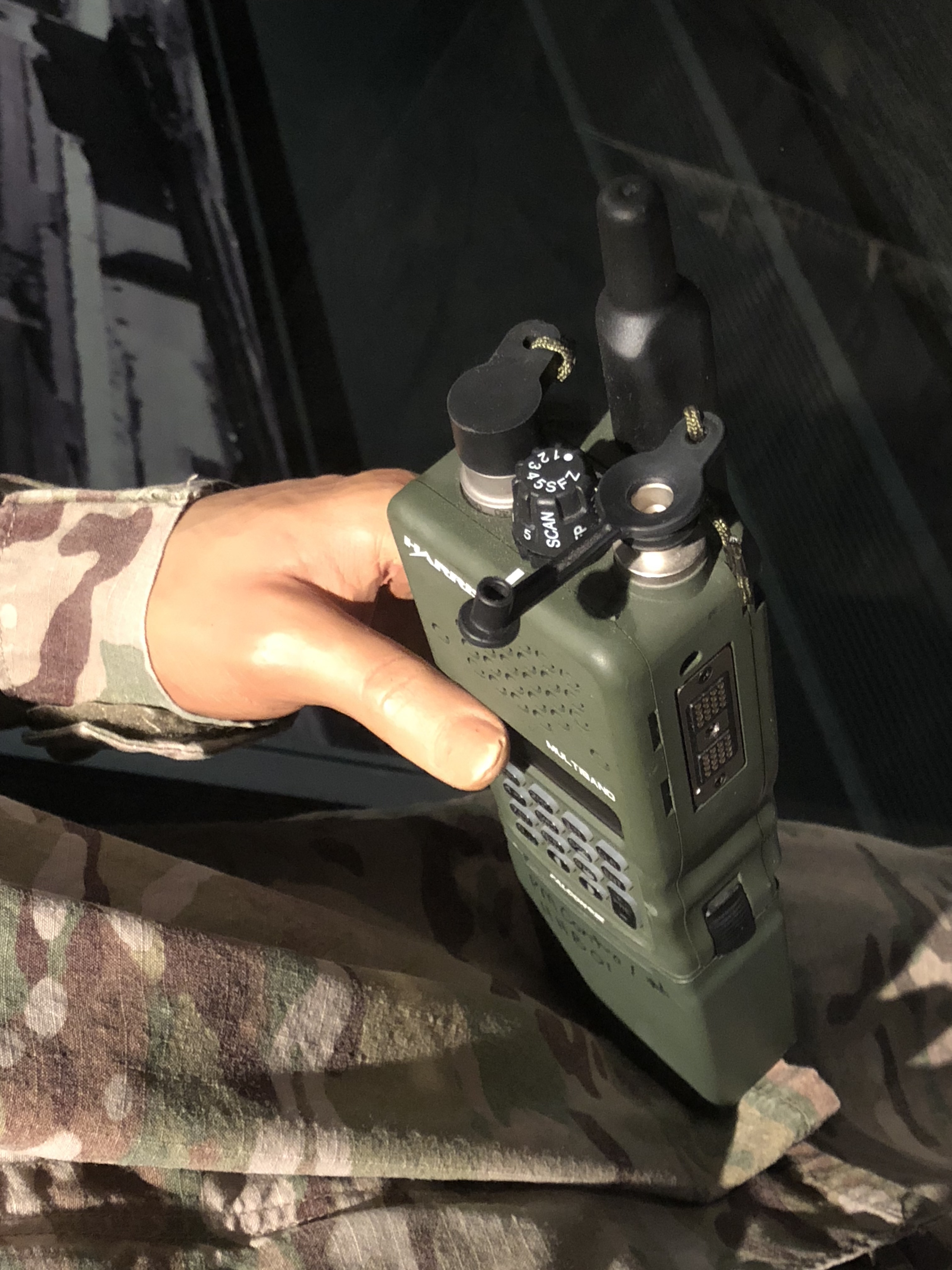|
PRC-152
The AN/PRC-152 Multiband Handheld Radio, also known as Harris Falcon III, is a portable, compact, tactical software-defined combat-net radio manufactured by Harris Corporation. It is compliant without waivers to the Joint Tactical Radio System (JTRS) Software Communications Architecture (SCA). It has received NSA certification for the transmission of Top Secret data. The designation AN/PRC signifies Army/Navy Portable Radio used for two way Communications and is based on the Joint Electronics Type Designation System guidelines. Users The AN/PRC-152 radio is currently in use with the US Navy Explosive Ordnance Disposal (EOD) teams in their MRAP JERRV vehicles. As of 2005, 1,300 radios have also been fielded in vehicles by the US Army. and more than 8,600 have been fielded by the U.S. Marines. An undetermined number are in use by the US Air Force in Iraq and Afghanistan. More recently the radio was photographed with Prince Harry, then a 23-year-old second lieutenant in the Househo ... [...More Info...] [...Related Items...] OR: [Wikipedia] [Google] [Baidu] |
AN/PRC-117F
The AN/PRC-117 translates to "Army/Navy, Portable, Radio, Communication". It is a man-portable, tactical software-defined combat-net radio, manufactured by Harris Corporation, in two different versions: * AN/PRC-117F Falcon II MBMMR (Multiband Multimission Manpack Radio), also referred to as AN/PRC-117F-MP, covering the 30-512 MHz frequency range, provided without an internal GPS (optionally an external commercial GPS can be connected, or a GPS SAASM as a PLGR (Precision Lightweight GPS Receiver) or a DAGR (Defense Advanced GPS Receiver); * AN/PRC-117G Falcon III MNMR (Multiband Networking Manpack Radio), also referred to as AN/PRC-117G-MP, covering the 30-2000 MHz frequency range, and provided with internal SAASM GPS (optionally an external commercial GPS can be connected). Both radios have NSA certification for the transmission of voice and data traffic up to the Top Secret level. The designation AN/PRC signifies "Army Navy / Portable Radio Communications" and is b ... [...More Info...] [...Related Items...] OR: [Wikipedia] [Google] [Baidu] |
Combat-net Radio
In telecommunication, a combat-net radio (CNR) is a radio operating in a network that (a) provides a half-duplex circuit and (b) uses either a single radio frequency or a discrete set of radio frequencies when in a frequency hopping mode. CNRs are primarily used for push-to-talk-operated radio nets for command and control of combat, combat support, and combat service support operations among military ground, sea, and air forces. In the United States, two military standards govern the use of combat net radios and the host applications that communicate over the network: MIL-STD-188-220 and MIL-STD-2045-47001. In addition to IETF RFCs governing UDP, TCP, and IPv4/IPv6, all seven layers of the OSI communications architecture are addressed. MIL-STD-2045-47001 covers layer 7 ( application), while MIL-STD-188-220 covers layers 1 through 3 (physical, data link, and network). Examples *AN/PRC-152 by Harris Corporation * AN/PRC-117 * AN/PRC-77 *SINCGARS * AN/PRC-148 MBITR *PR4G by Thales ... [...More Info...] [...Related Items...] OR: [Wikipedia] [Google] [Baidu] |
Joint Tactical Radio System
The Joint Tactical Radio System (JTRS) aimed to replace existing radios in the American military with a single set of software-defined radios that could have new frequencies and modes (“waveforms”) added via upload, instead of requiring multiple radio types in ground vehicles, and using circuit board swaps in order to upgrade. JTRS has seen cost overruns and full program restructurings, along with cancellation of some parts of the program. JTRS is widely seen as one of the DoD's greatest acquisition failures, having spent $6B over 15 years without delivering a radio. JTRS HMS (Handheld, Manpack & Small Form-Fit (SFF)) radios are jointly developed and manufactured by Thales and General Dynamics Mission Systems. These software-defined radios are designed as successors to the JTRS-compatible CSCHR (Consolidated Single Channel Handheld Radios, ie. AN/PRC-148 and AN/PRC-152), securely transmitting voice and data simultaneously using Type 2 cryptography and the new Soldier R ... [...More Info...] [...Related Items...] OR: [Wikipedia] [Google] [Baidu] |
Amplitude Modulation
Amplitude modulation (AM) is a modulation technique used in electronic communication, most commonly for transmitting messages with a radio wave. In amplitude modulation, the amplitude (signal strength) of the wave is varied in proportion to that of the message signal, such as an audio signal. This technique contrasts with angle modulation, in which either the frequency of the carrier wave is varied, as in frequency modulation, or its phase, as in phase modulation. AM was the earliest modulation method used for transmitting audio in radio broadcasting. It was developed during the first quarter of the 20th century beginning with Roberto Landell de Moura and Reginald Fessenden's radiotelephone experiments in 1900. This original form of AM is sometimes called double-sideband amplitude modulation (DSBAM), because the standard method produces sidebands on either side of the carrier frequency. Single-sideband modulation uses bandpass filters to eliminate one of the sidebands and ... [...More Info...] [...Related Items...] OR: [Wikipedia] [Google] [Baidu] |
AN/PYQ-10
The AN/PYQ-10 Simple Key Loader (SKL) is a ruggedized, portable, hand-held fill device, for securely receiving, storing, and transferring data between compatible cryptographic and communications equipment. The SKL was designed and built by Ralph Osterhout and then sold to Sierra Nevada Corporation, with software developed by Science Applications International Corporation (SAIC) under the auspices of the United States Army. It is intended to supplement and eventually replace the AN/CYZ-10 Data Transfer Device (DTD). The PYQ-10 provides all the functions currently resident in the CYZ-10 and incorporates new features that provide streamlined management of COMSEC key, Electronic Protection (EP) data, and Signal Operating Instructions (SOI). Cryptographic functions are performed by an embedded KOV-21 card developed by the National Security Agency (NSA). The AN/PYQ-10 supports both the DS-101 and DS-102 interfaces, as well as the KSD-64 The KSD-64 Crypto Ignition Key (CIK) is an NS ... [...More Info...] [...Related Items...] OR: [Wikipedia] [Google] [Baidu] |
AN/CYZ-10
A fill device or key loader is a module used to load cryptographic keys into electronic encryption machines. Fill devices are usually hand held and electronic ones are battery operated. Older mechanical encryption systems, such as rotor machines, were keyed by setting the positions of wheels and plugs from a printed keying list. Electronic systems required some way to load the necessary cryptovariable data. In the 1950s and 1960s, systems such as the U.S. National Security Agency KW-26 and the Soviet Union's Fialka used punched cards for this purpose. Later NSA encryption systems incorporated a serial port fill connector and developed several common fill devices (CFDs) that could be used with multiple systems. A CFD was plugged in when new keys were to be loaded. Newer NSA systems allow " over the air rekeying" (OTAR), but a master key often must still be loaded using a fill device. NSA uses two serial protocols for key fill, DS-101 and DS-102. Both employ the same U-229 6-pi ... [...More Info...] [...Related Items...] OR: [Wikipedia] [Google] [Baidu] |
Fill Device
A fill device or key loader is a module used to load cryptographic keys into electronic encryption machines. Fill devices are usually hand held and electronic ones are battery operated. Older mechanical encryption systems, such as rotor machines, were keyed by setting the positions of wheels and plugs from a printed keying list. Electronic systems required some way to load the necessary cryptovariable data. In the 1950s and 1960s, systems such as the U.S. National Security Agency KW-26 and the Soviet Union's Fialka used punched cards for this purpose. Later NSA encryption systems incorporated a serial port fill connector and developed several common fill devices (CFDs) that could be used with multiple systems. A CFD was plugged in when new keys were to be loaded. Newer NSA systems allow " over the air rekeying" (OTAR), but a master key often must still be loaded using a fill device. NSA uses two serial protocols for key fill, DS-101 and DS-102. Both employ the same U-229 6-pi ... [...More Info...] [...Related Items...] OR: [Wikipedia] [Google] [Baidu] |
Advanced Encryption Standard
The Advanced Encryption Standard (AES), also known by its original name Rijndael (), is a specification for the encryption of electronic data established by the U.S. National Institute of Standards and Technology (NIST) in 2001. AES is a variant of the Rijndael block cipher developed by two Belgian cryptographers, Joan Daemen and Vincent Rijmen, who submitted a proposal to NIST during the AES selection process. Rijndael is a family of ciphers with different key and block sizes. For AES, NIST selected three members of the Rijndael family, each with a block size of 128 bits, but three different key lengths: 128, 192 and 256 bits. AES has been adopted by the U.S. government. It supersedes the Data Encryption Standard (DES), which was published in 1977. The algorithm described by AES is a symmetric-key algorithm, meaning the same key is used for both encrypting and decrypting the data. In the United States, AES was announced by the NIST as U.S. FIPS PUB 197 (FIPS 197) on Novemb ... [...More Info...] [...Related Items...] OR: [Wikipedia] [Google] [Baidu] |
FASCINATOR
A fascinator is a formal headpiece, a style of millinery. Since the 1990s, the term has referred to a type of formal headwear worn as an alternative to the hat; it is usually a large decorative design attached to a band or clip. In contrast to a hat, its function is purely ornamental: it covers very little of the head, and offers little or no protection from the weather. An intermediate form, incorporating a more substantial base to resemble a hat, is sometimes called a hatinator. Etymology The word "fascinator" is derived from the Latin verb ''fascinare'' ("to fascinate"), and simply means a thing or person that is enthralling or extremely interesting. Historically, the term was also applied to a person or animal with the (perhaps magical) power of rendering others unable to move or escape. History Earlier decorative headpieces It was customary for Christian women in Europe to wear some sort of headcovering. The European fashion of decorating the head with a hat can be tr ... [...More Info...] [...Related Items...] OR: [Wikipedia] [Google] [Baidu] |
KG-84
The KG-84A and KG-84C are encryption devices developed by the U.S. National Security Agency (NSA) to ensure secure transmission of digital data. The KG-84C is a Dedicated Loop Encryption Device (DLED), and both devices are General-Purpose Telegraph Encryption Equipment (GPTEE). The KG-84A is primarily used for point-to-point encrypted communications via landline, microwave, and satellite systems. The KG-84C is an outgrowth of the U.S. Navy high frequency (HF) communications program and supports these needs. The KG-84A and KG-84C are devices that operate in simplex, half-duplex, or full-duplex modes. The KG-84C contains all of the KG-84 and KG-84A modes, plus a variable update counter, improved HF performance, synchronous out-of-sync detection, asynchronous cipher text, plain text, bypass, and European TELEX protocol. The KG-84 (A/C) is certified to handle data at all levels of security. The KG-84 (A/C) is a Controlled Cryptographic Item (CCI) and is unclassified when unkeyed. Keyed ... [...More Info...] [...Related Items...] OR: [Wikipedia] [Google] [Baidu] |
ANDVT
The Advanced Narrowband Digital Voice Terminal (ANDVT) is a secure voice terminal for low bandwidth secure voice communications throughout the U.S. Department of Defense. Devices in the ANDVT family include the AN/USC-43 Tactical Terminal (TACTERM), the KY-99A Miniaturized Terminal (MINTERM), and the KY-100 Airborne Terminal (AIRTERM). ANDVT uses LPC-10 voice compression. The functions of the MINTERM are similar to those of the TACTERM; its updated design includes an improved modular architecture, and it has been reduced in size. The MINTERM is lightweight, low-power, single channel, half-duplex, narrowband/wideband/wireline terminal providing secure voice and data communications with full key distribution and remote rekey capabilities. The MINTERM is certified to secure traffic up to TOP SECRET. The MINTERM improvements include the following: *Concurrent voice and data modes enable the users to connect both data equipment and voice handsets. *VINSON (KY-57/58) mode of operation a ... [...More Info...] [...Related Items...] OR: [Wikipedia] [Google] [Baidu] |



_Round_Function.png)
